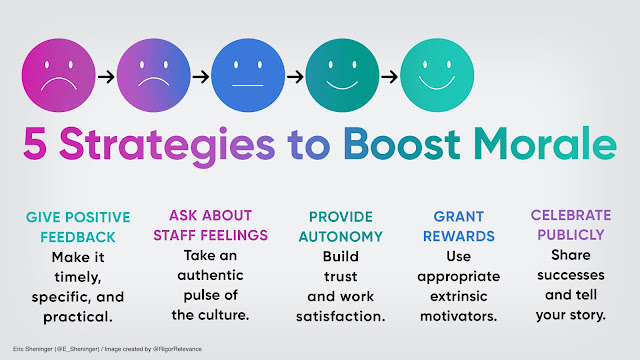Morale can best be defined as the confidence, enthusiasm, and discipline of a person or group at a particular time. Thriving cultures that produce results make every effort to keep this on the positive side. However, this is easier said than done. While the pandemic has undoubtedly played a monumental role in decreasing morale, other factors continuously play a role, such as leadership, mandates, lack of time, systems that are in place, a toxic culture, inadequate pay, or trying to maintain a work-life balance. No matter the cause, it’s up to the leader and their team to constantly be proactive to combat low morale.
Below are some simple strategies that you can use immediately and long-term, many of which are research-based.
Pile on the positive feedback
Sometimes there is never enough of a good thing when it comes to building up culture. Research has shown that feedback is vital in establishing good relations as it can enhance relationships, strengthen loyalty and commitment, and increase morale (Smith, 2009). When it comes to feedback, make sure it is timely, specific, practical, facilitated in a positive manner, and is a dialogue as opposed to a monologue. Actively look for opportunities to provide feedback through diverse means such as phone calls, paper notes, technology, and face-to-face conversations.
Actively inquire about how people are feeling
While this might seem like a no-brainer, it is not easy at times to know how people really feel unless diligent efforts are made to find out. Listening is one of the best tools that can be leveraged to gather crucial information on the pulse of a culture. Creating a roundtable for staff to share what is on their mind is another solid option, but digital forms that allow anonymous responses could very well be the best route.
Provide autonomy
Micro-managing never ends well. Using self-determination theory (Deci & Ryan, 2008), a study involving 735 workers was conducted to examine autonomy's impact on overall morale. Results revealed that work motivation was significantly related to both intraindividual (global motivation) and contextual factors (organizational support and supervisor autonomy support). It can be concluded that perceived organizational support and work autonomous motivation was positively related to work satisfaction (Gillet et al., 2013). As a principal, I created the Professional Growth Period (PGP) to grant unconditional autonomy to my staff.
Gift appropriate rewards
The key word above is appropriate. While I am a massive proponent of intrinsic means to improve motivation, that does not mean we cannot leverage extrinsic rewards as a means to boost morale. Examples include release time, professional learning opportunities off-site, a premium parking spot, tickets to school events, books, and school supplies. If you really want to boost morale, try eliminating as many after-school meetings as possible. The bottom line is that people want to be recognized, but morale will be most positively impacted by using authentic rewards that your staff value and do not see as disingenuous (White, 2014).
Celebrate publicly
It is hard to argue the fact that people want to have some semblance of fun and feel appreciated. A study using a large email survey of managers found overwhelming support for having fun in the workplace. Respondents reported that having a fun work environment will increase the levels of enthusiasm, satisfaction, creativity, communications among staff and enhanced feelings of group cohesiveness (Ford et al., 2004). Some schools have large-scale team-building events both on and off-site. If you go this route, elicit feedback from staff on what options they think will be best. You can also share stories across social media as a way to share successes more broadly, something I dive into deeply in Digital Leadership.
Sustaining and improving outcomes relies on good morale. It also plays a pivotal role in retaining our most precious people…those who commit themselves to serve kids.
Deci, E. & Ryan, R. (1994) Promoting Self‐determined Education, Scandinavian Journal of Educational Research, 38:1, 3-14.
Ford, R.C., Newstrom, J.W. and McLaughlin, F.S. (2004), "Making workplace fun more functional", Industrial and Commercial Training, Vol. 36 No. 3, pp. 117-120.
Gillet, N., Gagné, M., Sauvagère, S. & Fouquereau, E. (2013) The role of supervisor autonomy support, organizational support, and autonomous and controlled motivation in predicting employees' satisfaction and turnover intentions, European Journal of Work and Organizational Psychology, 22:4, 450-460.
Smith, D. C. (2008). Teaching Managers To Relate: Using Feedback To Bolster Commitment And Morale. Journal of Diversity Management (JDM), 3(3), 7–12.
White, P. (2014), "Improving staff morale through authentic appreciation", Development and Learning in Organizations, Vol. 28 No. 5, pp. 17-20.

No comments:
Post a Comment